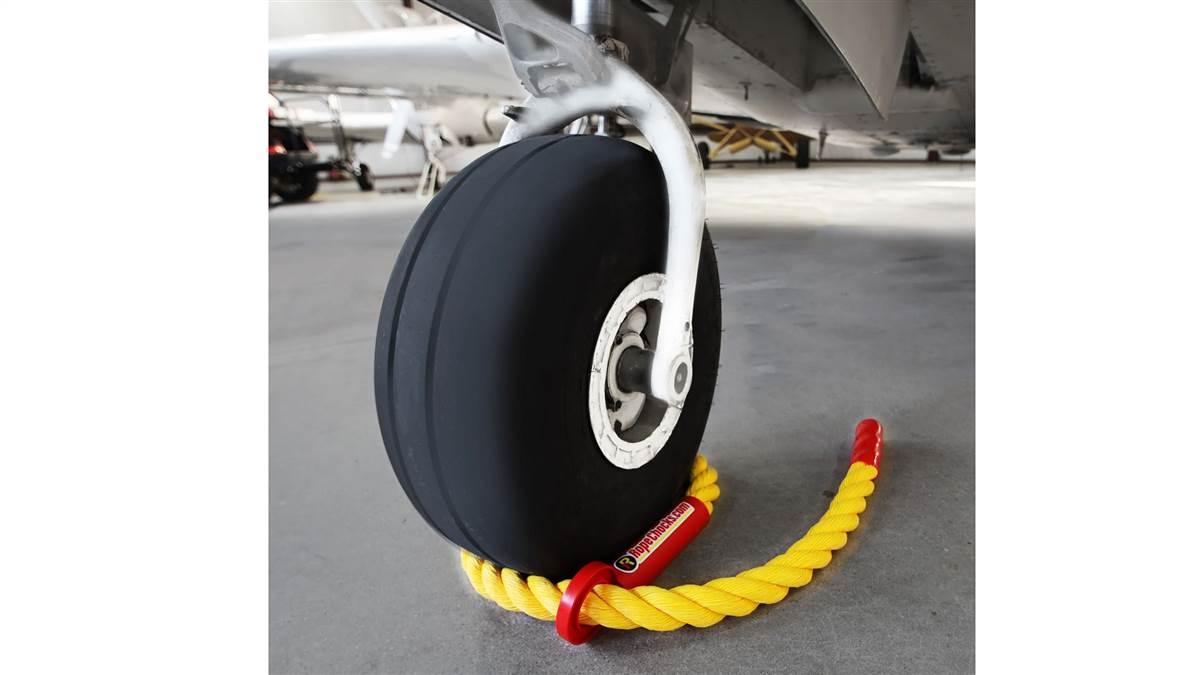Rope your airplane
A clever solution to keep your airplane from rolling

Little more than a 1.5-inch-thick piece of weather- and UV-resistant rope with a molded plastic endcap containing a hole large enough for the rope to slide through. Loop the rope on the ground around the base of an aircraft tire and pull the end of the rope through the endcap hole and the aircraft will stay put.
A lightweight rope chock from Rope Chocks was easy to use and not prone to loosening up in winds up to 10 knots (AOPA did not test the product in stronger winds), although the airplane could rotate in higher winds if only one rope chock is used. Still, that is preferable to traditional chocks that can separate and loosen up in mildly gusty winds.
The $40 price is not inexpensive, but the chocks come with a convenient carrying bag. At 1.5 pounds, the rope chocks weigh a little more than we were expecting—about the same as traditional wood chocks—and take up a little more space than traditional chocks. However, their one-size-fits-all nature make them handy portable pilot gear for any small- to medium-size GA airplane you might fly.
Sensorcon AV8 Inspector Pro
This might scare you
By Kollin Stagnito
 Think the $4 cardboard carbon monoxide detector stuck on the instrument panel of the airplane you are flying is sensitive enough to keep you informed of elevated CO levels in the cockpit? Think again.
Think the $4 cardboard carbon monoxide detector stuck on the instrument panel of the airplane you are flying is sensitive enough to keep you informed of elevated CO levels in the cockpit? Think again.
I tested the Sensorcon AV8 Inspector Pro in my 1947 Cessna 140 and was surprised by what I saw. At engine start, the CO level was very low—three parts per million (PPM). You can view the real-time CO level on the LCD screen, or you can press a “Max” button to display the maximum CO level from the time the unit was turned on. During takeoff and climbout, the reading increased to 17 PPM. Sounds scary, but the chart at right included with the instructions indicates this level is still relatively low.
What got my attention is that the CO reading in my airplane hit its highest level—26 PPM—after pulling the power back for landing. A slightly higher reading—35 PPM—would have set off a “low alarm” visual, audible, and vibration alert on the Sensorcon unit.
Was mycabin heat venting exhaust into the cockpit? Perhaps the carb heat? The real-time display on the unit enabled me to turn both systems on and off to see if affected the CO levels. This kind of troubleshooting is not possible with an inexpensive cardboard CO detector, which essentially indicates no CO or too much CO. Viewing real-time and Max readouts on the Sensorcon unit helps pilots and passengers understand their current level of exposure and risk before it’s too late.
Price: $169 from aircraftspruce.com



